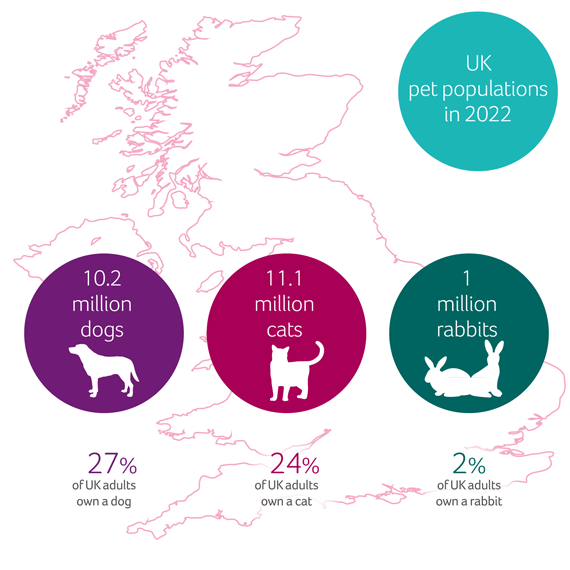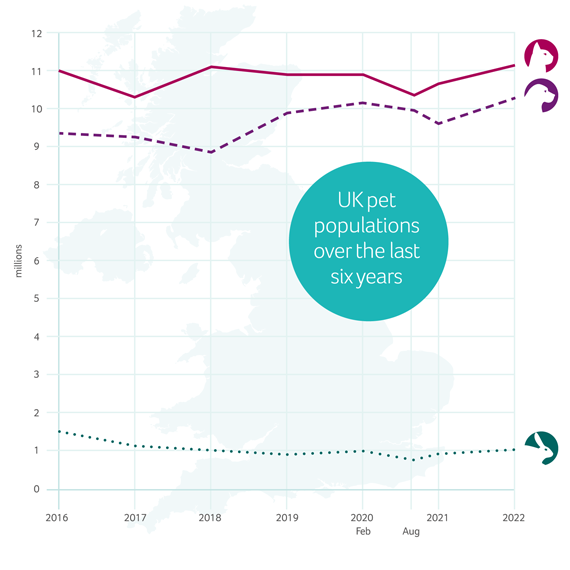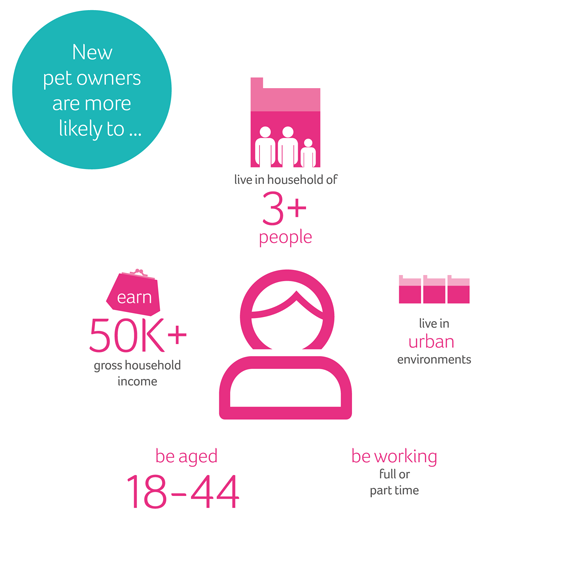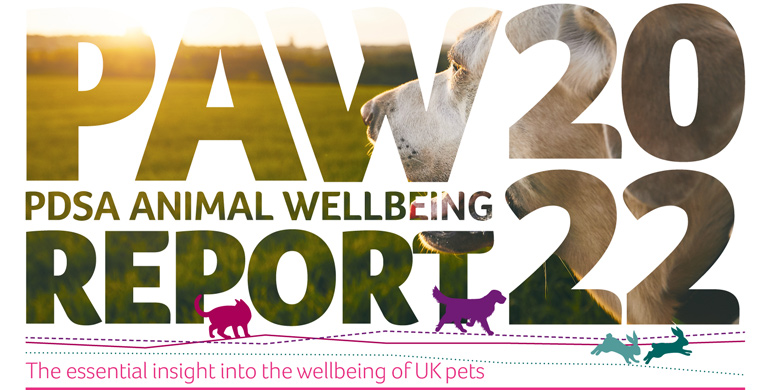Pet populations across the UK
Since 2011, on an annual basis, the PAW Report has collected nationally representative data to accurately determine the proportion of people in the UK who own a pet and to estimate the total population of the UK’s pet dogs, cats, and rabbits. Consistent methodology, applied over the last 12 years, enables us to compare the data and provides a true picture of how UK pet populations are changing.
While our data does show that the estimated population of pet dogs in the UK has increased to 10.2 million since our last Report in 2021 when it was 9.6 million, there has not been a statistically significant increase in the estimated population size of the UK’s pet dogs, cats and rabbits since February 2020.
The number of pets in the UK in 2022


Survey findings
We also found that a higher proportion of UK adults own a dog in 2022 (27%) compared to 2021 (26%). Compared to immediately prior to the pandemic, the proportion of people owning one dog has increased (70% in February 2020, 74% in 2022), while the proportion owning three or more dogs has decreased (7% in February 2020, 5% in 2022).
Although there does not appear to be a consistent trend across the 12 years of data on the estimated dog population, the proportion of UK adults who own a dog is higher in 2019 – 2022 compared to 2011 – 2014, despite fluctuating during the years in between. Since 2011, the dog population has risen from 8.3 million to 10.2 million currently.
The estimated population of pet cats and rabbits has not changed significantly since 2011, and neither has the proportion of UK adults who own these pets.
24% of all owners acquired their pet in the last two years, meaning that 5.4 million pets have been acquired since the start of the COVID-19 pandemic in March 2020. This is higher for rabbit owners (33%) compared to dog owners (25%) and cat owners (22%), equating to 2.5 million dogs, 2.5 million cats and 330,000 rabbits. This is comparable to data released by the Pet Food Manufacturers Association (PFMA), which found that 4.7 million2 pets had been acquired during the COVID-19 pandemic.
This level of acquisition is not different from previous data from 2017 to 2019 and Aug 2020 when 24%, 23%, 24% and 23% of owners acquired their pet in the preceding two years. Our findings from February 2020 showed that 22% of owners had acquired their pet in the preceding two years. That is slightly lower than the current 2022 figure (24%) but the trend over the last six years of data is stable.
36% of all pet owners told us that they were ‘new’ pet owners, i.e. this is their first experience of owning this species of pet as an adult. This has increased from 34% in 2021, largely due to an increase amongst dog owners, where 39% described themselves as new in 2022, compared to 34% in 2021. Rabbit owners were more likely than dog or cat owners to be ‘new’ owners at 48%, which is unchanged from 2021.
Similar to the 2021 data, this high proportion of ‘new’ owners in 2022 possibly reflects the continued increased demand for pets5 that may have been stimulated by lifestyle changes due to the COVID-19 pandemic. Combined with the increased proportion of UK adults who now own a dog compared to 2021 and the increase in the proportion of owners owning just one dog compared to February 2020, this may be contributing to the perception that the UK pet population has been increasing dramatically during the pandemic. It could also go some way towards explaining some of the workload and capacity pressures that the veterinary profession is currently struggling with6.
New* owners are more likely to be younger (68% of new owners are aged 18-44 compared to 27% of owners with previous experience of pet ownership) with a higher household income (37% of new owners have a gross household income of over £50,000 compared to 23% of experienced owners). In addition, new owners are more likely to be working full time or part-time (73% of new owners compared to 55% of experienced owners). This could reflect changing work practices during the pandemic, when office based jobs, which may have previously meant working away from home for long hours, became home based, so giving people an opportunity to own pets they may not have considered possible before. It could also relate to the rising cost of purchasing pets seen early on in the pandemic and the increased cost of living seen more recently. They were also more likely more likely to live in urban locations (76% of new owners compared to 67% of experienced owners) and to live in larger households (53% of new owners live in a household of 3 or more people compared to 38% of experienced owners).
Demographics of new pet owners
There are some interesting differences in the demographics of ownership amongst each species. Dog owners are less likely to be 25-34 (14%) or 35-44 (14%) compared to cat (16% and 17% respectively) and rabbit (23% and 23% respectively) owners but more likely to be 55+ (36%) compared to rabbit owners (16%).
Dog owners are less likely to live in household of 1 person (12%) or 2 people (40%) than cat owners (15%, 43%) but more likely than rabbit owners (6%, 31%). Dog owners are more likely to be in 3-4 person households (38%) or 5+ people (8%) than cat owners (34%, 6%) but less likely than rabbit owners (50%, 13%).
Dog owners are less likely to live in urban locations (68%) and more likely to live in rural locations (17%) compared to cat (73%, 14%) and rabbit (75%, 12%) owners.


Footnotes
* new owner defined as not having owned that species of pet before as an adult
5. Forbes (2022) Pandemic Puppies: Tackling A Growing Problem. https://www.forbes.com/uk/advisor/pet-insurance/pandemic-puppies/
6. BVA (2022) UK’s veterinary workforce crisis deepens as EU registrant numbers drop by over two-thirds since Brexit. https://www.bva.co.uk/news-and-blog/news-article/uk-s-veterinary-workforce-crisis-deepens-as-eu-registrant-numbers-drop-by-over-two-thirds-since-brexit/

